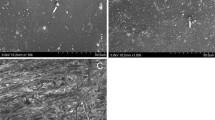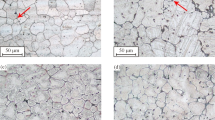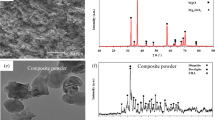Abstract
Magnesium alloys have shown prospective applications as a new biodegradable metal within bone. To garantee the longterm biocompatibility, a Mg-Zn-Ca alloy, composing of essential elements for human, was prepared and its feasibility for orthopedic applications was investigated. The in vitro and in vivo corrosion of Mg-Zn-Ca alloy as well as the biocompatibility were studied. The in vitro corrosion tests in five kinds of physiological solutions showed that the corrosion rates and corrosion morphologies of the alloy were strongly influenced by the solution used. The addition of serum in Hank’s and MEM significantly slowed down the corrosion rate and improved the corrosion uniformity of the alloy. The corrosion rate decreased with increasing serum concentration. The alloy showed the slowest corrosion rate as well as homogeneous corrosion morphology in MEM+10%FBS. Both the indirect and direct cell experiments indicated good cytocompatibility of the extruded Mg-Zn-Ca alloy. In vivo, we observed a gradual degradation process from the surface of extruded Mg-Zn-Ca alloy and only 40% in volume of implant was left after 4 weeks implantation in medullary cavities of mice. The micro-CT and histological analyses revealed its good biocompatibility with peri-implant new bone formation and increasing cortical bone thickness with increasing implantation period. This study showed that the extruded Mg-Zn-Ca alloy provided sufficient biocompatibility for orthopedic application, though the in vivo corrosion rate should be further reduced for clinical use.
摘要
可降解医用镁合金在骨科领域显示出良好的应用前景. 为了保证镁合金的生物相容性, 本文设计了全营养元素组成的Mg-Zn-Ca合金, 研究了其体内外腐蚀及生物相容性. Mg-Zn-Ca合金在五种模拟体液中的腐蚀测试结果表明在Hank’s和MEM中添加血清能够降低合金腐蚀速度, 并提高腐蚀均匀性. 血清浓度越高, 合金腐蚀速率越低. Mg-Zn-Ca合金在MEM+10%FBS溶液中腐蚀速率低, 腐蚀形貌均匀. 直接法和间接法的细胞实验结果均显示Mg-Zn-Ca合金具有良好的细胞相容性. 动物实验结果表明, Mg-Zn-Ca合金在小鼠骨髓腔内逐步降解, 4周后残余40 vol.%. micro-CT和组织学观察显示植入体周围有新骨形成, 且随着植入时间延长, 皮质骨厚度增加. 因此, 挤压态Mg-Zn-Ca合金具有良好的生物相容性, 有望用作骨科植入材料, 但是其体内降解速率还应进一步降低.
Similar content being viewed by others
References
Antunes RA, de Oliveira MCL. Corrosion fatigue of biomedical metallic alloys: Mechanisms and mitigation. Acta Biomater, 2012, 8: 937–962
Chen Q, Thouas GA. Metallic implant biomaterials. Mater Sci Eng-R-Rep, 2015, 87: 1–57
Raducanu D, Vasilescu E, Cojocaru VD, et al. Mechanical and corrosion resistance of a new nanostructured Ti–Zr–Ta–Nb alloy. J Mech Behav Biomed Mater, 2011, 4: 1421–1430
Zhao X, Niinomi M, Nakai M, et al. Development of high Zrcontaining Ti-based alloys with low Young’s modulus for use in removable implants. Mater Sci Eng-C, 2011, 31: 1436–1444
Wang J, Smith CE, Sankar J, et al. Absorbable magnesium-based stent: physiological factors to consider for in vitro degradation assessments. Regenerat Biomater, 2015, 2: 59–69
Zheng YF, Gu XN, Witte F. Biodegradable metals. Mater Sci Eng-R-Rep, 2014, 77: 1–34
Zeng RC, Cui L, Jiang K, et al. In vitro corrosion and cytocompatibility of a microarc oxidation coating and poly(l-lactic acid) composite coating on Mg–1Li–1Ca alloy for orthopedic implants. ACS Appl Mater Interfaces, 2016, 8: 10014–10028
Windhagen H, Radtke K, Weizbauer A, et al. Biodegradable magnesium-based screw clinically equivalent to titanium screw in hallux valgus surgery: short term results of the first prospective, randomized, controlled clinical pilot study. Biomed Eng Online, 2013, 12: 62
Liu Y, Zheng Y, Hayes B. Degradable, absorbable or resorbable— what is the best grammatical modifier for an implant that is eventually absorbed by the body? Sci China Mater, 2017, 60: 377–391
Witte F, Kaese V, Haferkamp H, et al. In vivo corrosion of four magnesium alloys and the associated bone response. Biomaterials, 2005, 26: 3557–3563
Angrisani N, Reifenrath J, Zimmermann F, et al. Biocompatibility and degradation of LAE442-based magnesium alloys after implantation of up to 3.5 years in a rabbit model. Acta Biomater, 2016, 44: 355–365
Grünewald TA, Ogier A, Akbarzadeh J, et al. Reaction of bone nanostructure to a biodegrading magnesium WZ21 implant—A scanning small-angle X-ray scattering time study. Acta Biomater, 2016, 31: 448–457
Ding W. Opportunities and challenges for the biodegradable magnesium alloys as next-generation biomaterials. Regen Biomater, 2016, 3: 79–86
Witte F, Hort N, Vogt C, et al. Degradable biomaterials based on magnesium corrosion. Curr Opin Solid State Mater Sci, 2008, 12: 63–72
Li Z, Gu X, Lou S, et al. The development of binary Mg–Ca alloys for use as biodegradable materials within bone. Biomaterials, 2008, 29: 1329–1344
Zheng YF, Gu XN, Xi YL, et al. In vitro degradation and cytotoxicity of Mg/Ca composites produced by powder metallurgy. Acta Biomater, 2010, 6: 1783–1791
Cai S, Lei T, Li N, et al. Effects of Zn on microstructure, mechanical properties and corrosion behavior of Mg–Zn alloys. Mater Sci Eng-C, 2012, 32: 2570–2577
Yan J, Chen Y, Yuan Q, et al. Comparison of the effects of Mg–6Zn and Ti–3Al–2.5V alloys on TGF-β/TNF-α/VEGF/b-FGF in the healing of the intestinal tract in vivo. Biomed Mater, 2014, 9: 025011
Bakhsheshi-Rad HR, Hamzah E, Fereidouni-Lotfabadi A, et al. Microstructure and bio-corrosion behavior of Mg-Zn and Mg-Zn-Ca alloys for biomedical applications. Mater Corrosion, 2014, 65: 1178–1187
Amerstorfer F, Fischerauer SF, Fischer L, et al. Long-term in vivo degradation behavior and near-implant distribution of resorbed elements for magnesium alloys WZ21 and ZX50. Acta Biomater, 2016, 42: 440–450
Hofstetter J, Martinelli E, Pogatscher S, et al. Influence of trace impurities on the in vitro and in vivo degradation of biodegradable Mg–5Zn–0.3Ca alloys. Acta Biomater, 2015, 23: 347–353
Wang H, Guan S, Wang Y, et al. In vivo degradation behavior of Ca-deficient hydroxyapatite coated Mg–Zn–Ca alloy for bone implant application. Colloids Surfs B-Biointerfaces, 2011, 88: 254–259
Tong LB, Zheng MY, Cheng LR, et al. Influence of deformation rate on microstructure, texture and mechanical properties of indirect-extruded Mg–Zn–Ca alloy. Mater Characterization, 2015, 104: 66–72
Tong LB, Zheng MY, Hu XS, et al. Influence of ECAP routes on microstructure and mechanical properties of Mg–Zn–Ca alloy. Mater Sci Eng-A, 2010, 527: 4250–4256
Waizy H, Seitz JM, Reifenrath J, et al. Biodegradable magnesium implants for orthopedic applications. J Mater Sci, 2013, 48: 39–50
Gu XN, Li N, Zhou WR, et al. Corrosion resistance and surface biocompatibility of a microarc oxidation coating on a Mg–Ca alloy. Acta Biomater, 2011, 7: 1880–1889
Gu XN, Xie XH, Li N, et al. In vitro and in vivo studies on a Mg–Sr binary alloy system developed as a new kind of biodegradable metal. Acta Biomater, 2012, 8: 2360–2374
Willbold E, Gu X, Albert D, et al. Effect of the addition of low rare earth elements (lanthanum, neodymium, cerium) on the biodegradation and biocompatibility of magnesium. Acta Biomater, 2015, 11: 554–562
Zeng RC, Hu Y, Guan SK, et al. Corrosion of magnesium alloy AZ31: The influence of bicarbonate, sulphate, hydrogen phosphate and dihydrogen phosphate ions in saline solution. Corrosion Sci, 2014, 86: 171–182
Xin Y, Huo K, Tao H, et al. Influence of aggressive ions on the degradation behavior of biomedical magnesium alloy in physiological environment. Acta Biomater, 2008, 4: 2008–2015
Wagener V, Virtanen S. Protective layer formation on magnesium in cell culture medium. Mater Sci Eng-C, 2016, 63: 341–351
Esmaily M, Svensson JE, Fajardo S, et al. Fundamentals and advances in magnesium alloy corrosion. Prog Mater Sci, 2017, 89: 92–193
Yang L, Hort N, Willumeit R, et al. Effects of corrosion environment and proteins on magnesium corrosion. Corrosion Eng Sci Tech, 2012, 47: 335–339
Yamamoto A, Hiromoto S. Effect of inorganic salts, amino acids and proteins on the degradation of pure magnesium in vitro. Mater Sci Eng-C, 2009, 29: 1559–1568
Fischer J, Pröfrock D, Hort N, et al. Improved cytotoxicity testing of magnesium materials. Mater Sci Eng-B, 2011, 176: 830–834
Wang J, Witte F, Xi T, et al. Recommendation for modifying current cytotoxicity testing standards for biodegradable magnesium-based materials. Acta Biomater, 2015, 21: 237–249
Noviana D, Paramitha D, Ulum MF, et al. The effect of hydrogen gas evolution of magnesium implant on the postimplantation mortality of rats. J Orthopaedic Translation, 2016, 5: 9–15
Kuhlmann J, Bartsch I, Willbold E, et al. Fast escape of hydrogen from gas cavities around corroding magnesium implants. Acta Biomater, 2013, 9: 8714–8721
Gu XN, Zheng YF. A review on magnesium alloys as biodegradable materials. Front Mater Sci China, 2010, 4: 111–115
Walker J, Shadanbaz S, Kirkland NT, et al. Magnesium alloys: Predicting in vivo corrosion with in vitro immersion testing. J Biomed Mater Res, 2012, 100B: 1134–1141
Kraus T, Fischerauer SF, Hänzi AC, et al. Magnesium alloys for temporary implants in osteosynthesis: In vivo studies of their degradation and interaction with bone. Acta Biomater, 2012, 8: 1230–1238
Willbold E, Kalla K, Bartsch I, et al. Biocompatibility of rapidly solidified magnesium alloy RS66 as a temporary biodegradable metal. Acta Biomater, 2013, 9: 8509–8517
Ullmann B, Reifenrath J, Seitz JM, et al. Influence of the grain size on the in vivo degradation behaviour of the magnesium alloy LAE442. Proc Inst Mech Eng H, 2013, 227: 317–326
Reifenrath J, Marten AK, Angrisani N, et al. In vitro and in vivo corrosion of the novel magnesium alloy Mg–La–Nd–Zr: influence of the measurement technique and in vivo implant location. Biomed Mater, 2015, 10: 045021
Acknowledgements
This work was supported by the National Natural Science Foundation of China (51401007, 11472032, 11120101001 and 11421202), a foundation for the author of the National Excellent Doctoral Dissertation of China (201463), Young Elite Scientists Sponsorship Program By CAST (2017QNRC001), and the National Key Research and Development Plan (2016YFC1102203 and 2016YFC1101100).
Author information
Authors and Affiliations
Corresponding authors
Additional information
Xuenan Gu received her PhD degree in mechanics (biomechanics and biomedical engineering) from Peking University, in 2011. Her research interests focus on the development of degradable metallic biomaterials and surface modification of biomedical magnesium alloys.
Yubo Fan received his PhD degree in biomechanics from Sichuan University, in 1992. His research interests focus on biomechanics and mechanobiology, medical appliances, biomaterials and tissue engineering.
Rights and permissions
About this article
Cite this article
Gu, X., Wang, F., Xie, X. et al. In vitro and in vivo studies on as-extruded Mg- 5.25wt.%Zn-0.6wt.%Ca alloy as biodegradable metal. Sci. China Mater. 61, 619–628 (2018). https://doi.org/10.1007/s40843-017-9205-x
Received:
Accepted:
Published:
Issue Date:
DOI: https://doi.org/10.1007/s40843-017-9205-x




